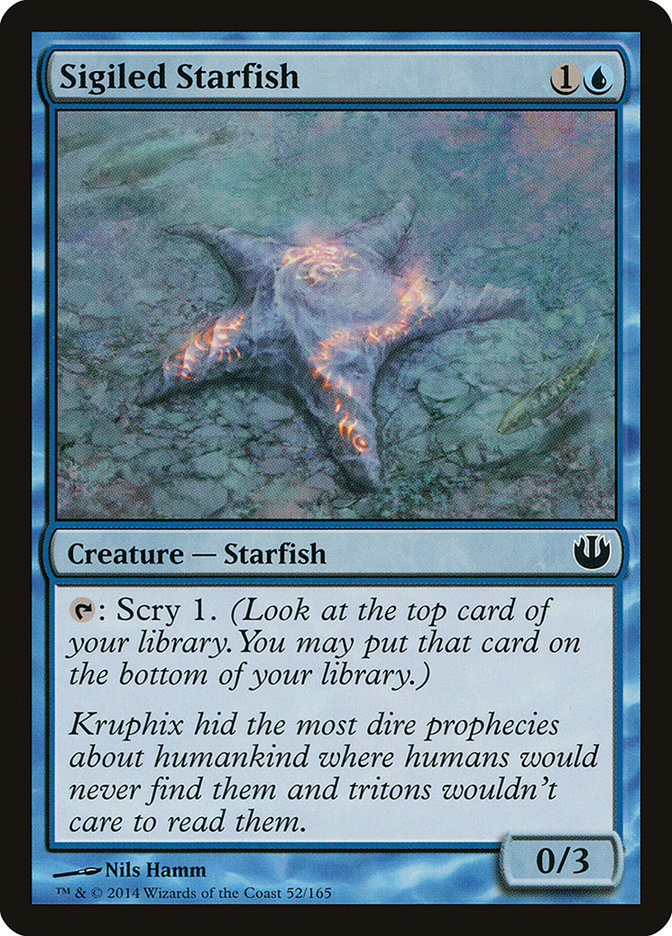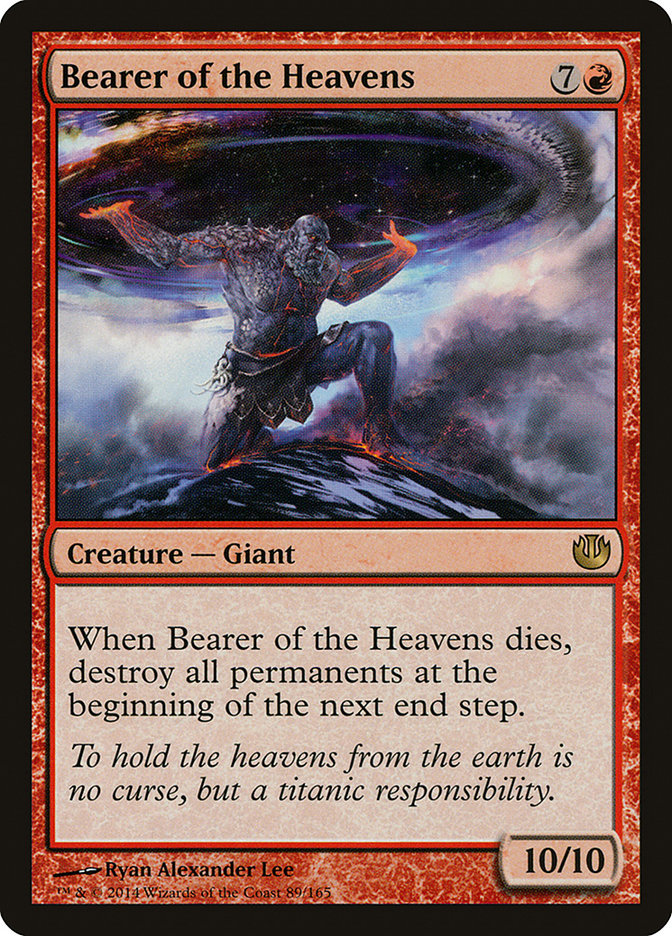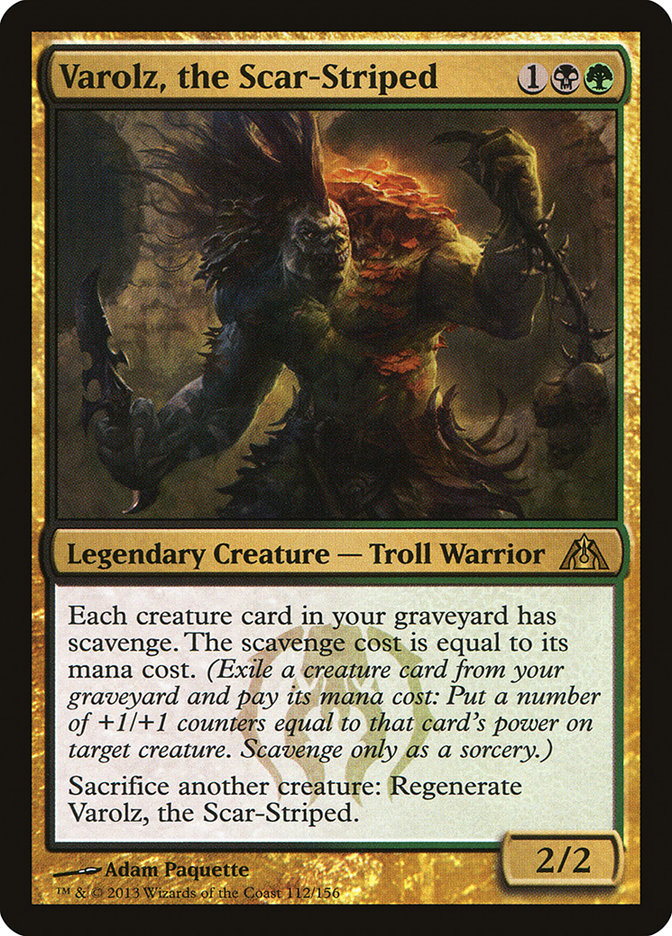What is it about Magic that makes it so fun to look at cards?

Half the people I know would be completely content to play Foresee in Standard. Look at four cards and draw two of them; there’s just something very fun
about seeing so much of your deck at a whack. Heck, I bet people would play a 6UU sorcery that said “Scry 12, then draw six cards.”
When scry appeared as a major mechanic in Theros, lots of people got excited. The likes of Preordain and Serum Visions have taught people how good scry is.
People who bashed the Temple cycle as being glorified Guildgates have seen how nice it is to have information and/or card selection on an uncounterable
land. Scry is at the forefront of people’s understanding of the entire block.
Which is why this card is so interesting.
From my personal experience, this random 0/3 for 1U was one of players’ favorite cards from the Prerelease and others have considered including a copy or
two in their Constructed brews as a replacement for Omenspeaker.
I’m not even concerned about the ability to manipulate your draw; I’m more interested in the fact that you have a controllable and repeatable way to
activate this card.
This little 2/3 is the latest in a long line of triggered power increasers like Kiln Fiend and Nivix Cyclops. In the past, some one-time event has
triggered the effect, but Flamespeaker is different; the effect that pumps the Adept is not only repeatable, but it filters your draw so that on a turn
where you scry several times, you’re able to more easily find the pieces you need to stay on the offense or to protect your Adept.
Theros Block has brought us the opportunity to scry after almost every kind of spell and ability. If you want to turn scrying into slaying, what can we do?
Creatures (16)
Lands (23)
Spells (21)

Part of the benefit of building a deck like this that has nearly perfect card choice is that, at any time, you can get exactly what you need. Do you need
tricks to push a single creature through? Scry away extra creatures. Need a threat? Tuck those lands. Kept a loose six? Put removal spells on the bottom in
search of timely land drops.
Creatures
These creatures were carefully selected for their cost and utility. All of them have the potential to kill an unprepared opponent. Even Sigiled Starfish
can silently kill your opponent with superior card selection.
Battlewise Hoplite is a great heroic target; it’s already reasonably sized, and every time you target the Soldier, it becomes larger and it gives you a
look at your next card. It’s nothing flashy, but it gets the job done. From there, we move on to Sigiled Starfish; free scry is really strong, especially
when you run out of steam. Playing the deck over and over will help you understand what you need in a given situation, so tapping the Starfish will become
more and more skillful. You’ll notice that it isn’t a defender; if need be, you can still strike your opponent with the help of a combat trick. How funny
would it be to defeat your opponent with a brainless echinoderm?
Flamespeaker Adept is definitely the card you need to protect. Although it’s fine to resolve her on the curve, keeping mana up for Gods Willing or another
protection spell isn’t a bad idea. If you untap with Flamespeaker Adept and a reasonable grip of cards, your opponent’s life total is your oyster. Finally,
Spellheart Chimera works well with the instant-based nature of the deck; every spell you cast constantly increases its power.
Spells
The spells are the stars of this show; Gods Willing is our format’s Stave Off, and the little bonus scry makes the Adept happy. Magma Jet is in the same
boat; the ability to choose your cards is worth sacrificing the one damage that Lightning Strike would provide. Titan’s Strength is an outstanding card,
letting any creature you control hit much more effectively. Any non-Fish creature effectively gains four power (or five in the Adept’s case) when you cast
this, and the extra toughness is not to be underestimated, especially if the opponent thinks that Bile Blight or Pharika’s Cure is going to kill your
target.
Boros Charm showcases its flexibility in this deck. If your Adept is already large, it can let you give it double strike and finish the job. It can protect
your team from destruction, as always, and it can deal four more damage after you’ve worn your opponent out. Spite of Mogis is a very efficient removal
spell that rewards you for casting combat tricks early and frequently. The ability to take down creatures red has no business taking down is an exciting
prospect. Although I considered Boros Reckoner to play a part in the deck (as well as to be a spicy target for Spite of Mogis), Spellheart Chimera is a bit
more interesting. Warleader’s Helix continues to be a midrange all-star, and I’m happy to include a single copy to aim at the face or a nuisance creature.
The mana base is a bit unusual. It plays a lot more Temples than is typical in a deck designed to kill you with small creatures; however, it is a free scry
effect and it allows you to fix effectively. A great number of the combat tricks cost only one mana, so it’s easy to play around the ETB disadvantage. A
pair of Mutavaults and Mana Confluence also seem fine. This deck seems likely to run out of gas if your opponent stabilizes, and Mutavault helps you slice
off a couple more points of life. It’s also a pocket pump target, if you have a couple of Titan’s Strength stranded in your hand.
The sideboard includes a playset of the Prophetic Flamespeaker. In a sense, this Flamespeaker is much like the Adept; any spell you cast makes this guy
better. Bear in mind that when this deals first strike damage, you can draw a potentially helpful pump spell to help one of your non-first strike
compatriots. Either way, the spells are cheap enough that you can often hit once and cast something relevant in your second main phase. Titan’s Strength
will make Prophetic Flamespeaker very challenging to block. Knowledge and Power offers a non-creature way to land the final blows. With a feel similar to
Crackling Perimeter, this card can flatten creatures or opponents for a small mana investment. Two mana for a Temple, Scryfish activation, or a spell
trigger can clear the path for your ground game or it can allow you an evasive win condition.
When removal is light and ground pounders can get slogged in your opponents’ chump blockers, Aqueous Form does a tidy job of slipping your now 4/3 Adept
with first strike past a sea of defenders. Just one blue mana ensures you’ll be able to cast another spell that turn, too. Rollick of Abandon was a weird
card when I saw it, at first, but I like it here. Everything but an infant Battlewise Hoplite survives the Rollick, and it can be a nifty Overrun effect
for a deck like this.
Deicide seems like a safe bet, and Detention Sphere and Banishing Light are the best removal spells some decks use. Having a cheap out to those as well as
an opportunity to undo Thassa, God of the Sea or Athreos, God of Passage make this slot more reasonable. Finally, a singleton Chandra, Pyromaster gives
additional reach. Sometimes you need just one more combat trick or the ability to remove a blocker to finish the game. Activating her -7 provides either
protection in the form of Gods’ Willing, a searing twelve damage from a burn spell, or an enormous Flamespeaker Adept getting +15/+3 from a Titan’s
Strength in triplicate.
This deck is not much of a stretch, but the card selection offered by so much scry should allow this deck to remain consistent enough to take out an FNM
that’s not prepared to deal with it. Get your top-card-lifting hand ready and try it yourself!

Thanks, John.
Today’s second deck is a little…different.
Everyone gets excited when Standard or Eternal staples are spoiled, but I get excited with those expensive, weird, how-will-anyone-ever-cast-this cards.
Enter Bearer of the Heavens.
Most people saw this card, said “Commander fodder,” and moved on to the shiny new lands and Gods present in this set. But not me.
Bearer of the Heavens, analogous to the mythological Atlas who held the heavens and earth on his shoulders, is a flavor home run. If you kill the bearer of
the world, it has a moment to fall, a moment for you and for every permanent to realize they’re done for before kaboom! The Gods survive, of
course, but everything else goes kaput. When it comes to Standard, it’s on par with Worldfire in that regard, but activating him allows you more control
than a clumsy nine-mana sorcery, and you’re able to scrounge actual advantage from it, where Worldfire made you work for it. My plan involves a simple,
hair-trigger interaction that puts you completely in control of the board state.
Cast that spell. I dare you.
Creatures (27)
- 1 Jarad, Golgari Lich Lord
- 4 Lotleth Troll
- 4 Slitherhead
- 4 Varolz, the Scar-Striped
- 4 Elvish Mystic
- 1 Tymaret, the Murder King
- 1 Xenagos, God of Revels
- 4 Satyr Wayfinder
- 1 Pharika, God of Affliction
- 3 Bearer of the Heavens
Planeswalkers (3)
Lands (22)
Spells (8)
Sideboard

Varolz, the Scar-Striped is probably my favorite guild champion from Dragon’s Maze, and here he provides additional value. Take Bearer of the Heavens,
sacrifice it to Varolz, and when the world is destroyed, he regenerates for free. Use what little mana you have left to scavenge onto Varolz and finish off
your opponent!
Creatures
Twenty-seven creatures each do their part to bring you and your opponent a step closer to oblivion. Elvish Mystic, a more interesting ramp spell than
Sylvan Caryatid in a deck of second-turn dredge and Domri Rade, provides an essential Turn 1 play. It cheaply scavenges as well, giving it added value
after it’s smitten. Slitherhead is a critical ally; once all your permanents are destroyed, this can scavenge onto Voralz for free,
letting you stack it onto Varolz immediately. It’s a fine blocker and Rescue from the Underworld fodder, too. Lotleth Troll can survive an earth-shattering
kaboom as well, though at the cost of mana. Normally I wouldn’t play so many, but here, they’re great blockers as you assemble your plan and monstrous
threats afterwards.
Satyr Wayfinder has wiggled its way into most every dredge deck, and this one is no exception. Varolz, who can be discarded or allowed to die if drawn in
multiples, is a free sacrifice outlet that works perfectly with the yard. Three Bearers make it in just to avoid the awkwardness of two or more in the
opening hand.
From there, four legendary creatures round out the creature offering. Jarad, Golgari Lich Lord is still a great dredge beast, and you can recover him from
the graveyard for “free.” Just sack the Swamp and Forest when the fuse has been lit. Tymaret, the Murder King can also be recovered after destruction; it
is also important to note that he can provide a sacrifice outlet after he’s already dead, providing a sneaky way to blow up the world. Pharika and Xenagos
both survive the cataclysm; Pharika’s devotion still has the potential to be close to critical quickly. Xenagos lets you play any threat
post-apocalyptically and deal major damage.
Spells
Domri Rade seems like another helpful creature searcher, and his ability to duel regenerating creatures with creatures that don’t regenerate seems
potentially important. Grisly Salvage and Rescue from the Underworld are the enablers of choice; Rescue from the Underworld can be used to pluck the Bearer
from the Heavens directly from the graveyard as a means to sacrifice the Bearer and return it safely at your next upkeep, ready to sacrifice it again. Sack
a Mutavault as a creature and you’ll even get a free land drop after the dust settles! I added a single Thoughtseize if you’re concerned about a
counterspell or hate card, but I didn’t like more than one.
The sideboard contains familiar, relevant creatures that can help you survive a more aggressive deck strategy. Abrupt Decay has Scavenging Ooze’s number,
and it still constitutes the largest mainstream threat to reanimator strategies.
This deck promises for some hilarious board states and politics between you and your fellow players. Just watch out for the Boros Charm blowout!
Both of these lists offer distinct, unique gaming experiences. Which would you play?




